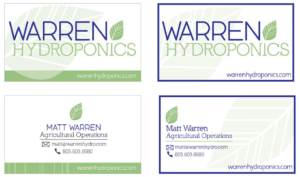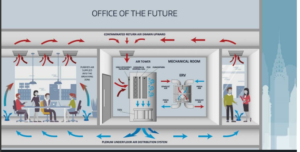There is a lot to understand when it comes to urban farming. Our experience with HVAC design compliments that of the grower to create optimal year-round growing conditions. Growers must be familiar with plant biology and what is key to successfully grow plants indoors, such as appropriate lighting and water to enable photosynthesis, and sometimes even movement of the plants to accommodate their growth cycle. With vertical farming, planters also must consider how exactly to arrange their microgreens, whether from the “ground” upward by using plant trays or in vertical columns running from the floor to the ceiling.
Whatever your reason for vertical farming may be, there are many HVAC considerations that must be evaluated to ensure the indoor farming environment is fully optimized to meet your growing needs. Here are a few examples of specific considerations we at NDBS evaluate and customize for each grow space:
It is understood that the mission for many urban farmers is to produce healthy and safe microgreens quickly and affordably. Because of this, the system must be designed to accommodate the grower’s needs, such as a desired vapor pressure deficit (VPD) which drives specific temperature and humidity conditions for the air surrounding the microgreens. Understanding this will help us design a conditioned space that is properly suited to grow your crops efficiently in a sustainable manner.
Temperature and humidity can greatly impact a plant’s physiology, photosynthesis process, and quality of growth. When the room air temperature rises, there is an increase in the loss of water through the plants which will increase space humidity. Humidity is tied to a plant’s ability to draw in CO2 and release oxygen and water. Too much humidity can potentially hinder the growth of the leafy greens and create an environment at risk of mold growth. NDBS will consider all the relevant factors in order to create the best growth environment for your crop.
Our HVAC team is here to help you design an energy-efficient airflow system that will result in swift payback. The major benefit of multi-tiered cultivation is the ability to expand canopy square footage without taking up more floor space. However, there are some challenges that come with this method of growing, such as ensuring the air conditions at each level are uniform and enabling the hot, humid air to make its way back to the HVAC system for removal. NDBS is able to retrofit any existing racking systems with custom designed airflow systems. Our designs can lessen the amount of equipment required to reach air flow targets, which cuts back on capital, operation, and energy costs to maximize profits for the facility.
Many factors influence the air velocity or air flow needs within a growing space, such as different canopy heights, various distances from LED lights and the amount of ductwork present. Unstable air velocity can affect VPD levels and thereby alter the plants’ transpiration rate, movement of water within the plant, and inhibit the gas exchange through the leaf stomata. Our HVAC system design must carefully consider the amount of air that is directed over the canopies to make sure that the optimal VPD is consistently being met.
Sustainability is a key feature that sets vertical farming apart from traditional farming. NDBS wants to ensure the longevity and profitability of your indoor farming space by incorporating sustainable practices into your facility, such as water conservation. Our HVAC team will develop a design that not only conserves–but also optimizes–the use of water, ensuring that all water that is removed from the space through the HVAC system is able to be recycled for reuse.
Growth Duration and Harvest Cycles
In outdoor farming, plants experience cyclical sunlight which results in a “light” and “dark” growing phase. Plant factories with artificial lighting (PFAL) simulate similar cycles using high intensity LED bulbs optimized for photosynthetic active radiation (PAR) to encourage plant growth. The light cycles drastically affect the temperature and humidity loads in the space. To accommodate for this, we must design a system that is appropriate for all potential lighting conditions.
Space loading and system operation for urban farming is much different than your usual comfort cooling applications for humans. Our HVAC team must consider the appropriate equipment that will properly cool, heat, and dehumidify the indoor farming space to preserve the temperature and humidity that is needed year-round for the plants to grow properly. NDBS will take an extensive look at your space to ensure that we are providing you with appropriately designed and cost-effective systems.


